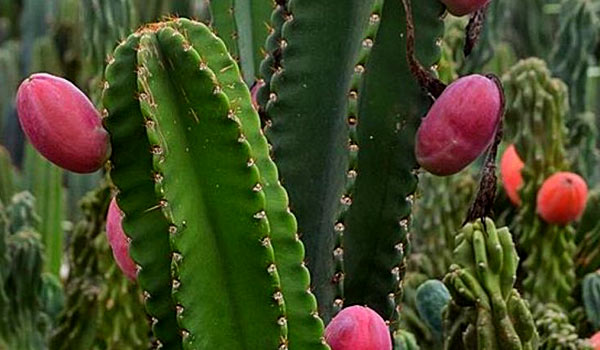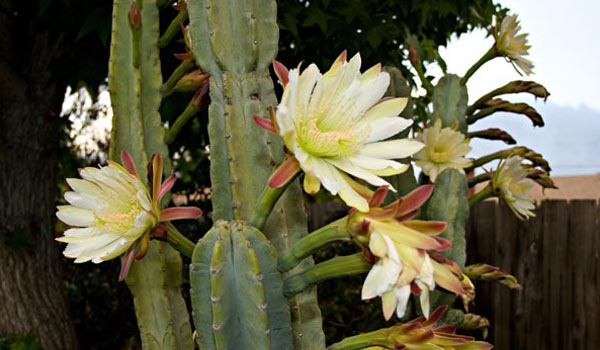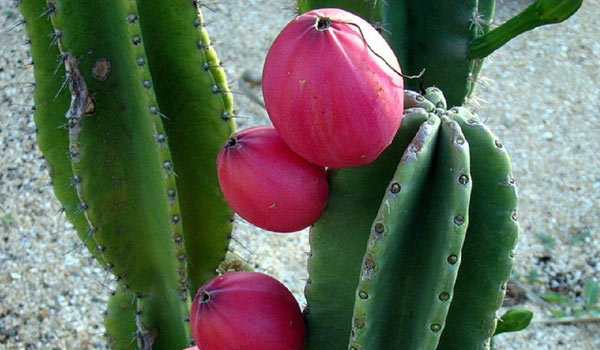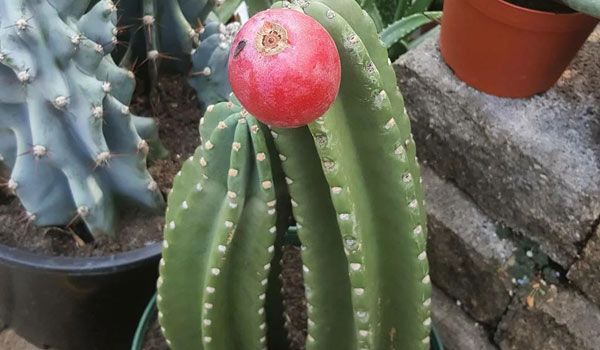Peruvian Apple Cactus Care & Grow Tips

The Peruvian apple cactus is a classic succulent with all the features that you are hoping for, such as attractive blooms, suitable size, and growth pattern, as well as convenient Peruvian apple cactus care.
This ornamental plant not also provides beautiful landscapes but also produces edible fruits called Peruvian apples. In the following parts, we’ll see how to propagate Peruvian apple cactus, how to care for it, and how to avoid its common problems. But first, let’s get to know this cactus better.

Apple Cactus Information
Scientifically named Cereus repandus or Cereus peruvianus (which is more common), this columnar plant is also known as Giant Club Cactus, Hedge Cactus, Night Blooming Cereus, and Queen of the Night. It is also called kayush and cadushi in Papiamento and Wayuunaiki, and is originally native to Brazil, Uruguay, and Argentina.
This tall and thorny plant has 9 to 10 rounded ribs that grow for about 0.4 inch. It has small areoles that are far apart, with variable straight spines that can be as long as almost 2 inches. The thorns are often numerous, but can also be missing entirely.
Peruvian apple cactus monstrose or the curiosity plant is a shorter variety of this plant. However, it has thick stems and larger fruits. This variety as well as the classic hedge cactus are mostly grown as an ornamental plant, but we shouldn’t forget about its edible “apples” and their inner cane-like wood that people use for constructing wattle and daub.
Peruvian Apple Cactus Height
This is a large plant with a tree-like appearance. In fact, it is one of the largest cacti species. It has cylindrical gray-green to blue stems that can grow up to 33 feet in height and 4 to 8 inches in diameter.
Regardless of the impressive Peruvian apple cactus height, this is a self-supporting plant. If supported using a scaffold, it can reach up to 110 feet, as the one did at a college in India, technically making it the tallest cactus in the world. Under natural conditions, it can’t grow taller than 82 feet.
As you can guess by these records, the Peruvian apple cactus growth rate is high. This plant grows quickly, about 2 to 4 feet in a year in ideal conditions.

Peruvian Apple Cactus Bloom & Fruit
Cereus peruvianus has large flowers with a showy cream color that appear in the summertime and are only open at night. The short-lived flowers stay open for a night and are vital for their pollination.
The Peruvian apple cactus blooms later turn into edible fruits or Peruvian apples (called Pitaya or Olala in some parts of Bolivia). The fruits have no thorns, and their skin color ranges from yellow to violet-red. Both the white flesh and its small crunchy seeds are edible. And as the fruit completely opens out, it gets sweeter.
In addition to its sweet taste, Peruvian apple cactus fruit health benefits are also interesting. These slightly acidic fruits are surprisingly nutritious since they contain high amounts of Vitamin C, beta-carotene, and fiber. You can simply spoon it out and eat it, or use it in a salad, smoothie, fruit salsa, or dessert recipes.
So, is Peruvian apple cactus fruit edible? Yes, and it is excellent to add to your diet thanks to its benefits. But the hedge cactus fruit health benefits are not just for us. In arid regions and dry seasons, they are an essential source of food for birds.
Peruvian Apple Cactus Cold Hardiness
This night-blooming plant is hardy to 18° F and will freeze in the lower temperatures. If growing outdoors, cover the ends of your plant with Styrofoam cups or sheets to protect during periods of frost. In the Peruvian apple cactus care, we’ll talk about the ideal temperatures more.

Peruvian Apple Cactus Care (Indoors & Outdoors)
Like other cacti, the Cereus repandus has relatively simple care requirements as well. It is a perfect plant to grow outdoors, but you can grow it indoors too (with a slightly slower growth rate). Here are the essential Peruvian apple cactus care tips you need to know:
Light & Temperature
We talked about Peruvian apple cactus hardiness in the previous paragraphs, now let’s see what kind of light and what temperatures it prefers. For the best growth, provide it with as much sun as possible:
- If you are growing one indoors, consider a south-facing window with a temperature around 77° F. If you choose another spot, you’ll notice it leaning towards the light. If such a location is not available in your home, rotate the pot a few times a year to even out the leaning.
- And if you are growing one outdoors, provide it with full sun (plus 8 hours per day)
Remember that this sturdy plant is not crazy about humidity.
How Often to Water Peruvian Apple Cactus
The hedge cactus watering need is the same as the other succulents. During its growth season (spring and summer), increase the watering.
In this period, the plant needs more water since it’s producing fruits and should support the new growth. Make sure to let the soil dry out almost completely before each irrigation. During the fall and winter, decrease the watering.
Soil & Fertilizer
The hedge cactus thrives best in well-draining soil. You can buy a cactus mix, and if it seems to maintain too much water, add some sand to improve the drainage. Your plant would also appreciate a slow-release granular organic fertilizer in its growing season.
This will boost growth. So if you are growing one in the pot, you may need to repot it sooner than you think!
Pruning
If you ever decided to prune your hedge cactus, fall is the best time; when it stops producing new branches, or when it is overgrown and you can hardly pick the fruits.
How to Pollinate Peruvian Apple Cactus
Since the flowers bloom at night, you need to hand-pollinate your plant to make sure good pollination and fruit formation. There are plenty of night pollinators out there (like moths and bats), so it’s not going to be a serious challenge. As the plant goes dormant, the fruits form in late fall to early winter
Pests & Diseases
The main growing issue that you need to keep an eye for, is overwatering which is fixable. If you are watering it correctly, but the signs of too much water are still there (such as the Peruvian apple cactus turning yellow), maybe the soil is not well-draining enough. In that case, add a bit of sand.
Tip: Stress and too much humidity can also turn your cactus yellow.
Snails, slugs, and mealybugs are pests that can cause problems for your Cereus peruvianus. To remove mealybugs, use organic insecticides or use cotton swabs soaked in rubbing alcohol to swab them off.

How to Grow Peruvian Apple Cactus from Cutting & Seeds
There are two methods for hedge cactus.
- You can propagate by taking cuttings from the stem top, which is a quicker way to have a mature plant. After removing the cutting, let it dry out and form callus for one or two weeks before planting in a well-draining cactus potting mix. To be successful, make sure to maintain a high temperature (more than 70 degrees).
You can also find small offsets at the plant base during spring or summer and simply plant them.
- Propagating this plant using seed is another option that is actually quite common; thanks the tendency of the seeds to germinate relatively quickly. However, it isn’t better than the last method. Plant the seeds in a well-draining soil mixture. You can use this method outdoors as well; but if you live in a cool area, we recommend indoor propagating.
- In this post:
- Apple Cactus Information
- Peruvian Apple Cactus Care (Indoors & Outdoors)
- How to Grow Peruvian Apple Cactus from Cutting & Seeds



